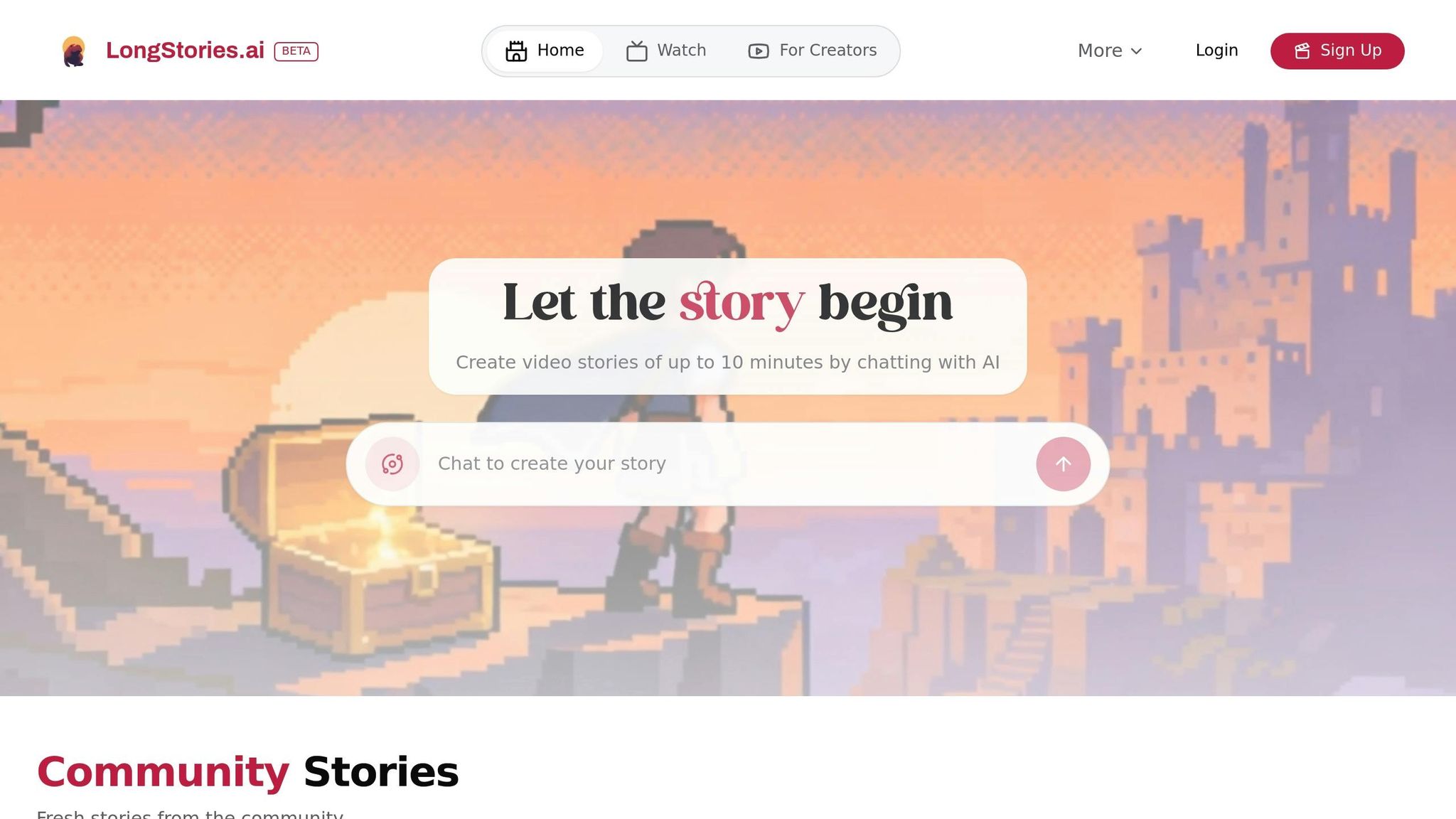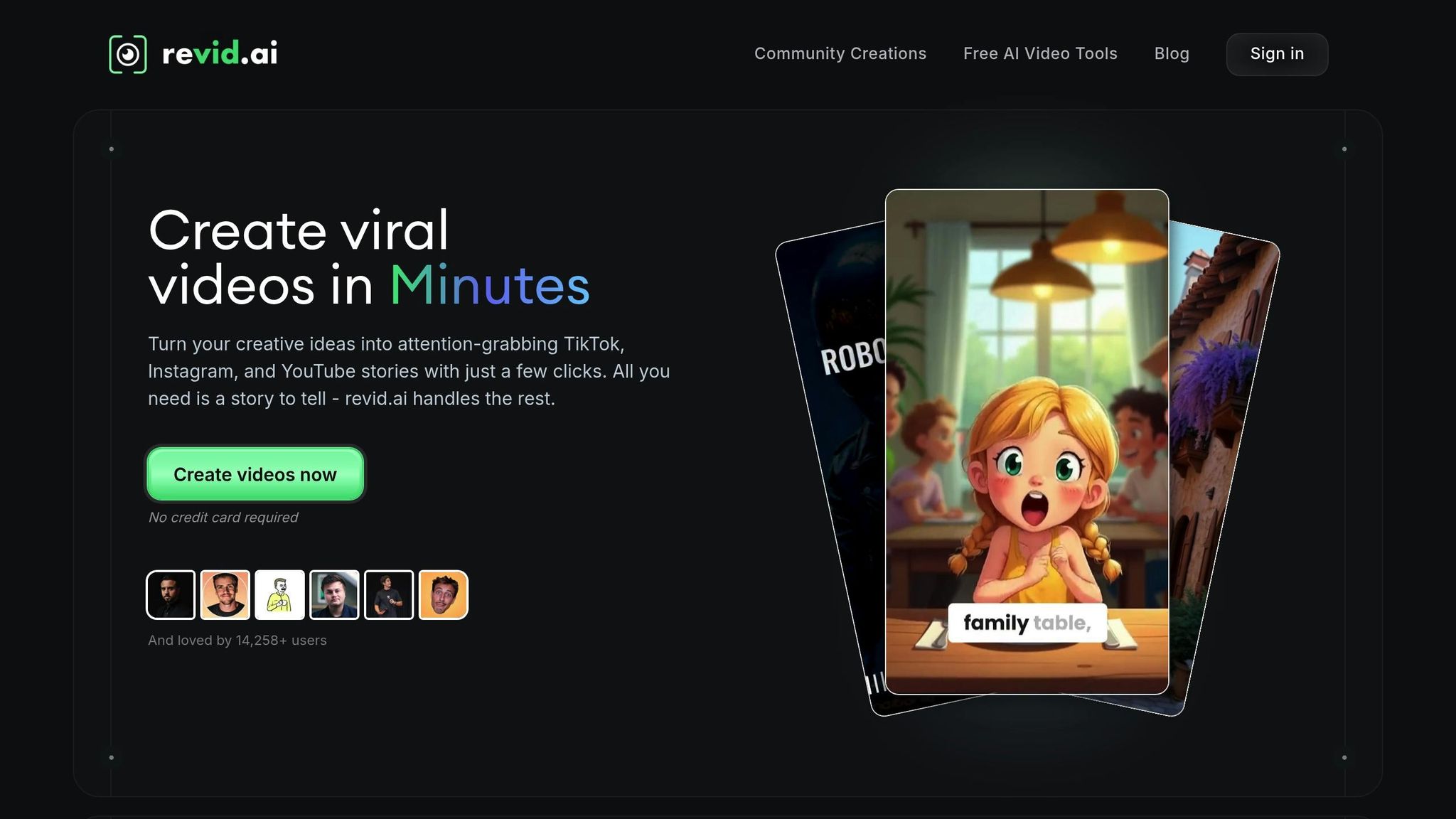
LongStories is constantly evolving as it finds its product-market fit. Features, pricing, and offerings are continuously being refined and updated. The information in this blog post reflects our understanding at the time of writing. Please always check LongStories.ai for the latest information about our products, features, and pricing, or contact us directly for the most current details.
AI Moderation for Long-Form Videos
AI moderation for long-form videos is now a pressing challenge for platforms like YouTube and TikTok. Unlike short clips, extended videos require systems to analyze complex narratives, audio, and visuals over time. Current moderation tools often fail to maintain context, leading to missed violations or false flags. With stricter regulations in Europe and the U.S., platforms face legal risks if they don’t proactively address harmful content.
Key players in this space include LongStories.ai, Gcore, Revid.ai, and Sora, each offering different solutions:
- LongStories.ai focuses on creating animated 10-minute videos but lacks transparency in moderation strategies.
- Gcore excels in enterprise-level moderation with real-time and batch processing, breaking videos into segments for context retention.
- Revid.ai balances safety and usability with multi-modal analysis but struggles with highly complex content.
- Sora remains unclear about its moderation processes, leaving questions about compliance and effectiveness.
Quick Comparison
| Platform | Strengths | Weaknesses | Pricing |
|---|---|---|---|
| LongStories.ai | Budget-friendly, supports animation | Limited to animated formats, unclear moderation | $9.99/month (beta) |
| Gcore | Scalable, real-time processing | Expensive, complex setup | Enterprise pricing |
| Revid.ai | Easy to use, automated workflows | Limited customization, less robust | Budget-friendly |
| Sora | High-quality video creation | Undefined moderation processes | Not disclosed |
Platforms must balance cost, compliance, and moderation effectiveness. The right choice depends on your content needs, whether live streams or pre-recorded videos.
Using AI to Automate Moderation of User-Generated and Third-Party Media Content
1. LongStories.ai

LongStories.ai shines a spotlight on the challenges tied to moderating extended video formats. This AI-driven platform transforms text prompts into fully animated, voice-narrated 10-minute stories. With over 5,000 video adventures created, it’s clear that LongStories.ai is making waves in the world of animated storytelling. However, its focus on creation rather than moderation brings attention to the growing difficulties of managing long-form content.
Supported Video Lengths
What sets LongStories.ai apart is its ability to produce 10-minute videos. This stands in contrast to platforms that cap content at 60 seconds or less. The extended format allows for richer narratives, more developed characters, and a depth of storytelling that's rare in shorter videos.
That said, the platform’s moderation strategies remain largely under wraps. This lack of transparency underscores a broader challenge faced by the industry: finding effective ways to manage and moderate the complexities of long-form video content.
2. Gcore AI Content Moderation

Gcore takes a technical approach to moderating video content, aligning with LongStories.ai's emphasis on creative storytelling. Its AI-powered system is designed to handle extended video streams, breaking them into segments for more precise analysis.
Supported Video Lengths
Whether it's a brief clip or a multi-hour broadcast, Gcore can handle it all. By dividing longer videos into smaller, manageable sections, it ensures that the context is preserved while keeping the computational demands in check.
Moderation Techniques
Gcore employs a layered detection system that integrates visual, audio, and contextual analysis. Through temporal analysis, it identifies patterns that evolve over time, catching violations that might otherwise go unnoticed. Additionally, its behavioral pattern recognition flags content that might appear harmless on its own but becomes concerning when viewed in context.
Real‑Time vs. Batch Processing
Gcore offers two processing modes to suit different needs. For pre-recorded videos, the batch mode provides thorough, in-depth analysis. For live streams, the real-time mode ensures immediate intervention when necessary, keeping inappropriate content in check as it happens.
3. Revid.ai

Revid.ai strikes a balance between ensuring content safety and meeting the creative demands of long-form video production. Unlike platforms that focus purely on enforcement, it recognizes that longer videos often require a nuanced approach, benefiting from thoughtful and detailed analysis.
Supported Video Lengths
Revid.ai adapts its analysis based on the length of the video. For shorter clips, it applies detailed frame-by-frame analysis, while for longer content, it uses strategic sampling to maintain context without overwhelming the process.
Moderation Techniques
Using multi-modal analysis, Revid.ai examines visuals, audio, and text all at once. Its models, trained on creator-generated content, are designed to differentiate between legitimate, nuanced discussions and clear policy violations. A contextual engine tracks narrative arcs to determine when sensitive content is part of valid expression. Additional tools like sentiment analysis and speaker identification help refine its moderation process further.
Real-Time vs. Batch Processing
Revid.ai offers a flexible approach to processing. For live streams, it provides near real-time monitoring with a slight delay to ensure accuracy. For pre-recorded content, batch processing identifies flagged timestamps and includes confidence indicators. For time-sensitive projects, a priority option speeds up the process without sacrificing precision.
Compliance and Reporting Features
Revid.ai simplifies compliance by generating detailed reports that include category breakdowns and visual indicators. It also maintains audit trails with stored logs and offers customizable policy templates to help creators align with platform and advertiser expectations.
sbb-itb-94859ad
4. Sora

Sora, an AI-driven video generation platform, has not shared detailed information about how it moderates long-form videos. Unlike other platforms that provide insights into their moderation practices or compliance strategies, Sora's methods remain unclear. For now, its approach is undocumented, leaving room for further clarification from the platform.
Advantages and Disadvantages
Choosing the right AI moderation platform for long-form video content means weighing the strengths and limitations of each option. Here's a breakdown to help content creators and administrators make informed decisions:
| Platform | Advantages | Disadvantages |
|---|---|---|
| LongStories.ai | • Tailored for long-form content (up to 10 minutes) • Affordable beta pricing at $9.99 • 400 free credits for new users |
• Only supports animated cartoon formats |
| Gcore AI Content Moderation | • Scalable for enterprise needs • Strong compliance framework • Real-time processing • Supports multiple video formats |
• Expensive for enterprise users • Setup and integration can be complex • May require technical expertise |
| Revid.ai | • Intuitive interface • Quick and easy deployment • Budget-friendly for smaller creators • Automated workflows |
• Limited customization options • Struggles with complex, nuanced long-form content • Less robust compared to enterprise platforms |
| Sora | • Advanced AI for video creation • High-quality output • Utilizes cutting-edge technology |
• Moderation workflows are not clearly defined • Compliance standards lack transparency • Limited clarity in overall processes |
Several factors influence which platform is the best fit, including pricing, technical complexity, and content format compatibility.
For pricing, options range from LongStories.ai's budget-friendly plans for individual creators to Gcore's custom enterprise solutions, which cater to larger organizations. If ease of use is a priority, platforms like Revid.ai stand out, while enterprise-level solutions often require more advanced technical setups.
Content format flexibility is another key consideration. LongStories.ai specializes in animated formats, while other platforms, such as Gcore, accommodate a variety of video types, including live-action, screen recordings, and mixed media.
Transparency is especially critical for organizations focused on compliance. Platforms with well-documented moderation processes provide better audit trails and regulatory assurance. On the other hand, options like Sora may leave users uncertain about their compliance standards. These trade-offs highlight the balance between creative flexibility and meeting strict moderation requirements.
Conclusion
Moderating long-form video content with AI brings unique hurdles, demanding platforms that cater to both the needs of creators and the operational goals of organizations. LongStories.ai stands out in this space, offering support for 10-minute animated stories at a starting price of $9.99, which includes 400 free credits. With over 5,000 stories already created, it presents a budget-friendly and efficient solution for creators.
Meanwhile, platforms like Gcore AI Content Moderation, Revid.ai, and Sora provide alternative tools. However, details about their moderation processes, compliance standards, and scalability are limited. This lack of clarity makes it critical for users to thoroughly evaluate how these platforms align with their specific content needs and regulatory requirements.
As we've explored, moderating long-form video content successfully requires a nuanced approach to managing context. Choosing the right platform isn't about finding a universal solution - it’s about identifying one that meets your unique content, budget, and compliance needs. Striking the right balance between automation, accuracy, and transparency is key to achieving effective AI moderation.
FAQs
What makes AI moderation for long-form videos different from short clips, and what challenges does it face?
Moderating long-form videos with AI is far trickier than handling short clips. The extended runtime and complex, shifting content require AI systems to grasp evolving themes, subtle context changes, and a wide range of topics - all while maintaining accuracy. This makes it harder to consistently identify harmful or inappropriate material throughout the entire video.
One major challenge lies in preserving context. AI often struggles to link earlier parts of a video with later sections, which can lead to gaps in understanding. On top of that, analyzing longer videos takes up significantly more computational resources and time, slowing down the moderation process. Thankfully, advancements in AI, like better contextual comprehension and scalable processing capabilities, are making strides to tackle these challenges head-on.
What should content creators look for in an AI moderation platform for long-form videos?
When selecting an AI moderation platform for long-form videos, there are a few important aspects to keep in mind to ensure the tool aligns with your needs. Accuracy should be a top priority since long-form content often includes intricate dialogue and complex scenes that demand careful evaluation. It's also essential that the platform can handle longer video durations without losing performance quality.
Key features to consider include customizable moderation settings, compatibility with different types of content, and the ability to scale up for larger projects. For creators working on long-form AI-generated videos, tools like LongStories.ai can enhance your process by providing resources to create engaging, animated stories with ease. By finding the right balance between moderation functionality and content creation tools, you can achieve polished, professional results.
Why is transparency in AI moderation important, and how does it impact compliance with regulations in the U.S. and Europe?
Transparency in AI moderation matters because it fosters trust with users and holds platforms accountable for how they manage content. When moderation processes are clear and open, they show that decisions are fair, free from bias, and guided by ethical principles. This becomes even more critical when dealing with long-form video content, where the added complexity of nuance and context makes moderation decisions more challenging.
On the regulatory side, both the U.S. and Europe have established strict rules for content moderation, addressing issues like misinformation, hate speech, and user privacy. Transparent practices not only help platforms stay compliant with these laws but also minimize the risk of penalties and strengthen their standing with both creators and audiences. Take, for example, platforms like LongStories.ai, which focus on producing long-form AI-generated videos. By embracing transparent moderation, they can ensure their content meets these regulatory standards while maintaining credibility and trust.
